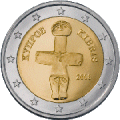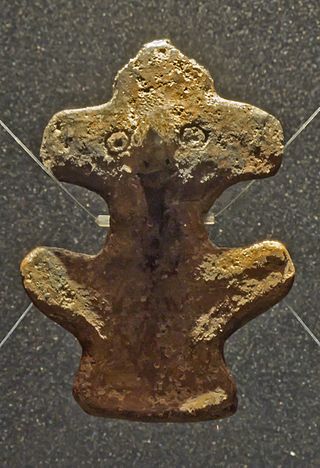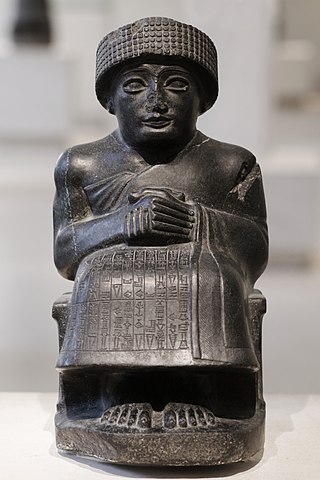

The Idol of Pomos is a stone prehistoric sculpture found near the Cypriot village of Pomos. It dates back to the Chalcolithic period, circa the 30th century BC. [1]
Contents
The sculpture is on display in the Cyprus Museum in Lefkosia (Nicosia).


The Idol of Pomos is a stone prehistoric sculpture found near the Cypriot village of Pomos. It dates back to the Chalcolithic period, circa the 30th century BC. [1]
The sculpture is on display in the Cyprus Museum in Lefkosia (Nicosia).
The sculpture probably represents a woman crouching with her arms spread. The gender is assumed from many similar sculptures found in Cyprus with small protrusions on their chests to indicate the female gender. These figurines were probably used as a fertility symbol. Bleda During, however, suggests that these figurines represent a sort of dance. [2] Smaller versions were worn as amulets around the neck, just as this idol wears (a small copy of) itself.
In 2008 Cyprus adopted the Euro. The Idol, a representation of Cypriot prehistoric art, was chosen to be displayed on the Cypriot euro coins of 1 and 2 euro. [3]

Byblos, also known as Jebeil, Jbeil or Jubayl, is an ancient city in the Keserwan-Jbeil Governorate of Lebanon. The area is believed to have been first settled between 8800 and 7000 BC and continuously inhabited since 5000 BC. During its history, Byblos was part of numerous cultures including Egyptian, Phoenician, Assyrian, Persian, Hellenistic, Roman, Genoese, Mamluk and Ottoman. Urbanisation is thought to have begun during the third millennium BC and it developed into a city making it one of the oldest cities in the world, if not the oldest. It is a UNESCO World Heritage Site.

A Venus figurine is any Upper Palaeolithic statue portraying a woman, usually carved in the round. Most have been unearthed in Europe, but others have been found as far away as Siberia and distributed across much of Eurasia.

The Thinker, by Auguste Rodin, is a bronze sculpture depicting a nude male figure of heroic size, seated on a large rock, leaning forward, right elbow placed upon the left thigh, back of the right hand supporting the chin in a posture evocative of deep thought and contemplation. This universally recognized expression of “deep thought” has made the sculpture one of the most widely known artworks in the world. It has become the iconic symbol of thinking; images of the sculpture in profile are often used to indicate philosophy and other practices of contemplation or introspection.

The archaeology of Israel is the study of the archaeology of the present-day Israel, stretching from prehistory through three millennia of documented history. The ancient Land of Israel was a geographical bridge between the political and cultural centers of Mesopotamia and Egypt.

The Löwenmensch figurine, also called the Lion-man of Hohlenstein-Stadel, is a prehistoric ivory sculpture discovered in Hohlenstein-Stadel, a German cave, part of the Caves and Ice Age Art in the Swabian Jura UNESCO World Heritage Site, in 1939. The German name, Löwenmensch, meaning "lion-person" or "lion-human", is used most frequently because it was discovered and is exhibited in Germany. It is an anthropomorphic figurine combining a human-like body with the head of a cave lion.
Cypriot euro coins feature three separate designs for the three series of coins. Cyprus has been a member of the European Union since 1 May 2004, and is a member of the Economic and Monetary Union of the European Union. It has completed the third stage of the EMU and adopted the euro as its official currency on 1 January 2008.

Lempa is a village in Cyprus located approximately 4 km (2.5 mi) north of the town of Paphos. It is sometimes written as Lemba, which is also closer to the correct pronunciation. Neighbouring villages are Empa, Kissonerga and Chlorakas.

The ancient Cycladic culture flourished in the islands of the Aegean Sea from c. 3300 to 1100 BCE. Along with the Minoan civilization and Mycenaean Greece, the Cycladic people are counted among the three major Aegean cultures. Cycladic art therefore comprises one of the three main branches of Aegean art.

The Archaeological Museum of Nafplio is a museum in the town of Nafplio of the Argolis region in Greece. It has exhibits of the Neolithic, Chalcolithic, Helladic, Mycenaean, Classical, Hellenistic and Roman periods from all over southern Argolis. The museum is situated in the central square of Nafplion. It is housed in two floors of the old Venetian barracks.

Alaminos is a village in the Larnaca District of Cyprus, west of the city of Larnaca. In 1960, it had 564 inhabitants, with a roughly equal number of Greek and Turkish Cypriots. In 2011, its population was 345.

Guatimac or the Idol of Guatimac is an owl-shaped Guanche cult image, found in 1885, hidden in a cave between the municipalities of Fasnia and Güímar wrapped in goat hide.

The Ain Sakhri figurine or Ain Sakhri Lovers is a Natufian sculpture that was found in one of the Ain Sakhri caves near Bethlehem. It is approximately 11,000 years old and thought to be the oldest known representation of two people engaged in sexual intercourse. It is held by the British Museum.

The Venus of Moravany is a small prehistoric Venus figurine discovered in Slovakia in the early 20th century.

The art of Mesopotamia has survived in the record from early hunter-gatherer societies on to the Bronze Age cultures of the Sumerian, Akkadian, Babylonian and Assyrian empires. These empires were later replaced in the Iron Age by the Neo-Assyrian and Neo-Babylonian empires. Widely considered to be the cradle of civilization, Mesopotamia brought significant cultural developments, including the oldest examples of writing.

Larnaca District Museum is a museum in Larnaca, Cyprus that has displays that show the "historical development of the city of Kition and the District of Larnaka in general." It was inaugurated in 1969. and was formerly named Larnaca District Archaeological Museum. It is controlled by the Department of Antiquities.
The Tell Brak Head is an important prehistoric Middle Eastern sculpture found at the ancient site of Tell Brak in Syria. It has been part of the British Museum's collection since 1939. Dated by archaeologists to before 3300 BC, it is considered to be one of the oldest portrait busts from the Middle East.

Aydın Archaeological Museum is in Aydın, western Turkey. Established in 1959, it contains numerous statues, tombs, columns and stone carvings from the Hellenistic, Roman, Byzantine, Seljuk and Ottoman periods, unearthed in ancient cities such as Alinda, Alabanda, Amyzon, Harpasa, Magnesia on the Maeander, Mastaura, Myus, Nisa, Orthosia, Piginda, Pygela and Tralleis. The museum also has a section devoted to ancient coin finds.

The Vénus impudique is the first Paleolithic sculptural representation of a woman discovered in modern times. It was found by Paul Hurault, 8th Marquis de Vibraye in about 1864 at the famous archaeological site of Laugerie-Basse in the Vézère valley.
Can Hasan 1 Mound is an archaeological site located near the village of Alaçatı, formerly known as Can Hasan, approximately 12–15 km northeast of the city center of Karaman province, Turkey. It is situated about 750 meters southeast of Can Hasan 3 Mound. Among the trio of mounds known by the same name in the vicinity of Can Hasan Village, Can Hasan 1 is attributed to the Chalcolithic Age, Can Hasan 2 to the Hellenistic, Roman, and Byzantine periods, and Can Hasan 3 to the Neolithic Age settlement.